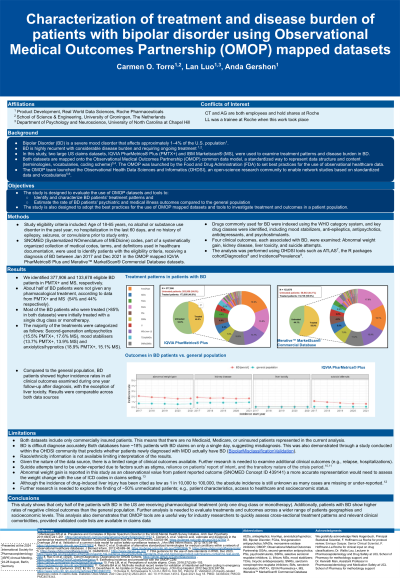Methods
Session: Poster Session B
(173) Characterization of treatment and disease burden of patients with bipolar disorder using Observational Medical Outcomes Partnership (OMOP) mapped datasets
Tuesday, August 27, 2024
8:00 AM - 6:00 PM CEST
Location: Convention Hall II


Carmen O. Torre, MS (she/her/hers)
Senior Data Scientist
Roche, United Kingdom- LL
Lan Luo
Roche, United States
- AG
Anda Gershon
Roche, United States
Presenting Author(s)
Co-Author(s)
Background: Bipolar Disorder (BD) is a severe mood disorder that affects approximately 1–4% of the U.S. population. BD is highly recurrent, with considerable disease burden, requiring ongoing pharmacological treatment3,4. In this study, we use two large US claims datasets to examine current treatment patterns and disease burden in BD.
Objectives: The study is designed to primarily identify and characterize BD patients' treatment patterns and, secondarily, to estimate the rate of BD patients' psychiatric and medical illness outcomes compared to the general population. OMOP versions of two US claims datasets are used with the scope of adopting the best practices for the use of observational healthcare in a standardised setting1,2,9.
Methods: This retrospective cohort study focused on adult patients (ages 18-65) diagnosed with BD between January 2017 and December 2021, followed up for one year after the first recorded diagnosis, from two US claims data sources mapped to OMOP: IQVIA PharMetrics® Plus (PMTX+) and IBM MarketScan® (MS). All patients had no history of alcohol or substance use disorders in the last year, no hospitalization in the last 60 days, and no prior history of epilepsy, seizures, or convulsions.
Drugs commonly used for BD were indexed using the WHO category system, and key drug classes were identified for this analysis: First-generation antipsychotics; Second-generation antipsychotics; Lithium; Other Mood stabilizers; Antiepileptics; Anxiolytics/Hypnotics; Selective serotonin reuptake inhibitors; Serotonin-norepinephrine reuptake inhibitors; Psychostimulants.
The study examined four clinical outcomes in these patients: Abnormal weight gain, kidney disease, liver toxicity, and suicidal attempts. The analysis was performed using OHDSI tools such as ATLAS5, the R packages cohortDiagnostics6 and IncidencePrevalence7.
Results: We identified 377,906 and 133,678 patients (for PMTX+ and MS respectively) About half of BD patients were not given any pharmacological treatment, according to data from PMTX+ and MS (54% and 44% respectively). Most of the BD patients who were treated (>85% in both datasets) were initially treated with a single drug class or monotherapy. The majority of the treatments fell under the following categories: Second-generation antipsychotics, mood stabilisers and anxiolytics/hypnotics. Compared to the general population, the BD patients showed higher rates of all of the clinical outcomes examined during follow-up.
Conclusions: There is a high unmet need for the treatment of BD as many patients are unmedicated. Furthermore, BD is a condition associated with high disease burden. Further analysis is needed to evaluate treatments across multiple countries.
Objectives: The study is designed to primarily identify and characterize BD patients' treatment patterns and, secondarily, to estimate the rate of BD patients' psychiatric and medical illness outcomes compared to the general population. OMOP versions of two US claims datasets are used with the scope of adopting the best practices for the use of observational healthcare in a standardised setting1,2,9.
Methods: This retrospective cohort study focused on adult patients (ages 18-65) diagnosed with BD between January 2017 and December 2021, followed up for one year after the first recorded diagnosis, from two US claims data sources mapped to OMOP: IQVIA PharMetrics® Plus (PMTX+) and IBM MarketScan® (MS). All patients had no history of alcohol or substance use disorders in the last year, no hospitalization in the last 60 days, and no prior history of epilepsy, seizures, or convulsions.
Drugs commonly used for BD were indexed using the WHO category system, and key drug classes were identified for this analysis: First-generation antipsychotics; Second-generation antipsychotics; Lithium; Other Mood stabilizers; Antiepileptics; Anxiolytics/Hypnotics; Selective serotonin reuptake inhibitors; Serotonin-norepinephrine reuptake inhibitors; Psychostimulants.
The study examined four clinical outcomes in these patients: Abnormal weight gain, kidney disease, liver toxicity, and suicidal attempts. The analysis was performed using OHDSI tools such as ATLAS5, the R packages cohortDiagnostics6 and IncidencePrevalence7.
Results: We identified 377,906 and 133,678 patients (for PMTX+ and MS respectively) About half of BD patients were not given any pharmacological treatment, according to data from PMTX+ and MS (54% and 44% respectively). Most of the BD patients who were treated (>85% in both datasets) were initially treated with a single drug class or monotherapy. The majority of the treatments fell under the following categories: Second-generation antipsychotics, mood stabilisers and anxiolytics/hypnotics. Compared to the general population, the BD patients showed higher rates of all of the clinical outcomes examined during follow-up.
Conclusions: There is a high unmet need for the treatment of BD as many patients are unmedicated. Furthermore, BD is a condition associated with high disease burden. Further analysis is needed to evaluate treatments across multiple countries.
